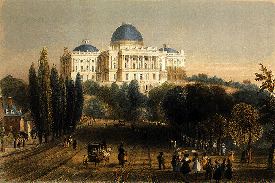The Twenty-fourth United States Congress was a meeting of the legislative branch of the United States federal government, consisting of the United States Senate and the United States House of Representatives. It met in Washington, D.C. from March 4, 1835 to March 4, 1837, during the seventh and eighth years of Andrew Jackson's presidency. The apportionment of seats in the House of Representatives was based on the Fifth Census of the United States in 1830. Both chambers had a Jacksonian majority.
December 28, 1835: The Second Seminole War began. Seminole fighter Osceola and his warriors attack government agent Thompson outside Fort King in central Florida.1835: Toledo War fought between Ohio and Michigan Territory over the city of Toledo and the Toledo Strip.February 3, 1836: United States Whig Party held its first convention in Albany, New York.February 23, 1836: Siege of the Alamo began in San Antonio, Texas.July 11, 1836: President Andrew Jackson issued the Specie Circular, beginning the failure of the land speculation economy that would lead to the Panic of 1837.July 13, 1836: U.S. patent #1 was granted after filing 9,957 unnumbered patents.November 3 - December 7, 1836: 1836 presidential election: Martin Van Buren defeated William Henry Harrison, but Virginia's electors refused to vote for Van Buren's running mate, thereby denying victory to any Vice Presidential candidate.December 4, 1836: Whig Party held its first national convention, in Harrisburg, Pennsylvania.December 15, 1836: The U.S. Patent Office (USPTO) burned in Washington, DC.February 8, 1837: Richard Mentor Johnson became the first and only Vice President of the United States elected by the United States Senate. The Senate was required to choose between Richard Johnson and Francis Granger as the next vice-president. Johnson was elected easily in a single ballot by 33 to 16:[Data unknown/missing. You can help!]
December 29, 1835: Treaty of New Echota signed, ceding all the lands of the Cherokee east of the Mississippi to the United StatesApril 20, 1836: Wisconsin Territory was formed from the Michigan TerritoryJune 15, 1836: Arkansas was admitted as the 25th state.January 26, 1837: Michigan was admitted as the 26th state.During this congress two Senate seats were added for each of the new states of Arkansas and Michigan.
During this congress one House seat was added for each of the new states of Arkansas and Michigan.
President: Martin Van Buren (J)President pro tempore: William R. King (J)Speaker: James K. Polk (J)This list is arranged by chamber, then by state. Senators are listed by class, and Representatives are listed by district.
Skip to House of Representatives, belowSenators were elected by the state legislatures every two years, with one-third beginning new six-year terms with each Congress. Preceding the names in the list below are Senate class numbers, which indicate the cycle of their election. In this Congress, Class 1 meant their term began in the last Congress, requiring re-election in 1838; Class 2 meant their term began with this Congress, requiring re-election in 1840; and Class 3 meant their term ended with this Congress, requiring re-election in 1836.
The names of members of the House of Representatives are preceded by their district numbers.
The count below reflects changes from the beginning of the first session of this Congress.
Replacements: 11Anti-Jacksonians: 5-seat net lossJacksonians: 10-seat net gainDeaths: 3Resignations: 8Interim appointments: 0Seats of newly admitted states: 4Total seats with changes: 16Replacements: 18Anti-Jacksonians: 5-seat net gainAnti-Masonics: 1-seat net lossJacksonians: 2-seat net lossNullifiers: No net changeDeaths: 5Resignations: 13Contested election: 0Seats of newly admitted states: 2Total seats with changes: 24Lists of committees and their party leaders.
AgricultureAudit and Control the Contingent Expenses of the SenateClaimsCommerceConstitution of the State of Arkansas (Select)Distributing Public Revenue Among the States (Select)District of ColumbiaFinanceForeign RelationsIncendiary Publications (Select)Indian AffairsJudiciaryLetter from Mr. Poindexter (Select)ManufacturesMileage of Members of Congress (Select)Military AffairsMilitiaNaval AffairsOhio-Michigan Boundary (Select)Patent Office (Select)PensionsPost Office and Post RoadsPrivate Land ClaimsPublic LandsPurchasing Boyd Reilly's Gas Apparatus (Select)Revolutionary ClaimsRoads and CanalsSale of Public Lands (Select)Tariff Regulation (Select)WholeAccountsAgricultureAmendment to the Constitution (Select)Banks of the District of Columbia (Select)ClaimsCommerceDistrict of ColumbiaElectionsExpenditures in the Navy DepartmentExpenditures in the Post Office DepartmentExpenditures in the State DepartmentExpenditures in the Treasury DepartmentExpenditures in the War DepartmentExpenditures on Public BuildingsForeign AffairsIndian AffairsInvalid PensionsManufacturesMilitary AffairsMilitiaNaval AffairsPost Office and Post RoadsPublic ExpendituresPublic LandsRevisal and Unfinished BusinessRevolutionary ClaimsRoads and CanalsRules (Select)Standards of Official ConductTerritoriesWays and MeansWholeEnrolled BillsLibrarian of Congress: John Silva MeehanChaplain: Edward Y. Higbee (Episcopalian), elected December 23, 1835John R. Goodman (Episcopalian), elected December 28, 1836Secretary: Walter Lowrie until December 11, 1836Asbury Dickens, elected December 12, 1836Sergeant at Arms: John ShackfordChaplain: Thomas H. Stockton (Methodist), elected December 7, 1835Oliver C. Comstock (Baptist), elected December 5, 1836Clerk: Walter S. FranklinDoorkeeper: Overton CarrSergeant at Arms: Roderick Dorsey, elected December 15, 1835Postmaster: William J. McCormick 
